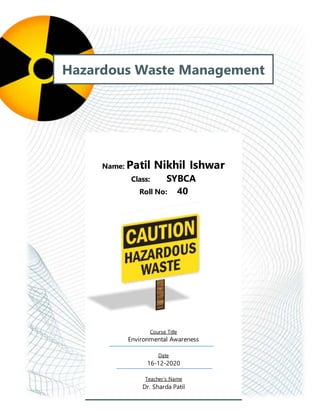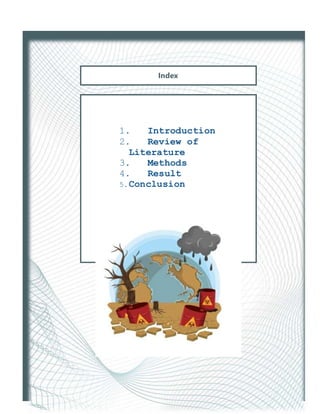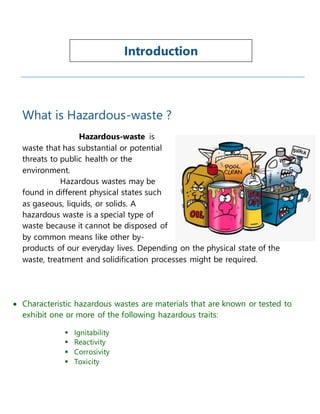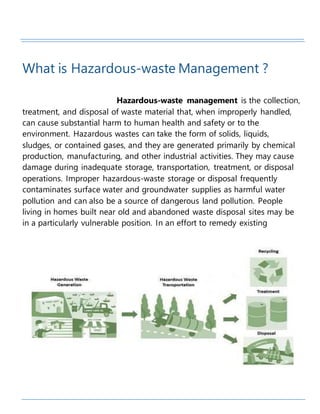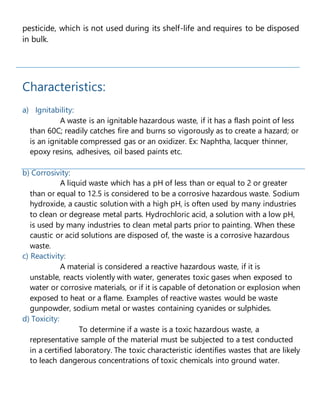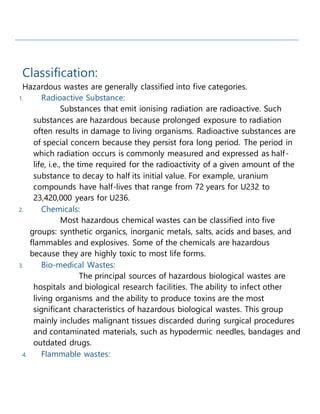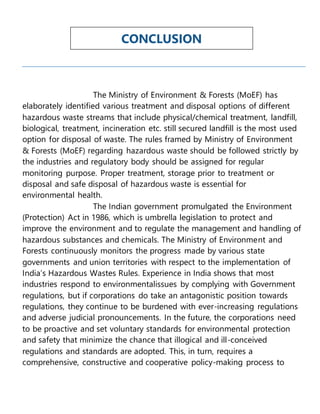Hazardous Waste Management.docx
- 1. Hazardous Waste Management Name: Patil Nikhil Ishwar Class: SYBCA Roll No: 40 Course Title Environmental Awareness Date 16-12-2020 Teacher’s Name Dr. Sharda Patil
- 2. Index 1. Introduction 2. Review of Literature 3. Methods 4. Result 5.Conclusion
- 3. What is Hazardous-waste ? Hazardous-waste is waste that has substantial or potential threats to public health or the environment. Hazardous wastes may be found in different physical states such as gaseous, liquids, or solids. A hazardous waste is a special type of waste because it cannot be disposed of by common means like other by- products of our everyday lives. Depending on the physical state of the waste, treatment and solidification processes might be required. Characteristic hazardous wastes are materials that are known or tested to exhibit one or more of the following hazardous traits: Ignitability Reactivity Corrosivity Toxicity Introduction
- 4. What is Hazardous-waste Management ? Hazardous-waste management is the collection, treatment, and disposal of waste material that, when improperly handled, can cause substantial harm to human health and safety or to the environment. Hazardous wastes can take the form of solids, liquids, sludges, or contained gases, and they are generated primarily by chemical production, manufacturing, and other industrial activities. They may cause damage during inadequate storage, transportation, treatment, or disposal operations. Improper hazardous-waste storage or disposal frequently contaminates surface water and groundwater supplies as harmful water pollution and can also be a source of dangerous land pollution. People living in homes built near old and abandoned waste disposal sites may be in a particularly vulnerable position. In an effort to remedy existing
- 5. problems and to prevent future harm from hazardous wastes, governments closely regulate the practice of hazardous-waste management. Need of waste management. The most important reason for hazardous waste collection is the protection of the environment and the health of the population. Rubbish and waste can cause air and water pollution. The hazardous waste requires to be disposed of in a secured manner in view of their characteristic properties. When Hazardous Wastes are not used efficiently by the waste generators, they cause severe pollution of land, surface, and ground water. How hazardous-waste are classified ? Hazardous wastes are classified on the basis of their biological, chemical, and physical properties. These properties generate materials that are either toxic, reactive, ignitable, corrosive, infectious, or radioactive. Toxic wastes are poisons, even in very small or trace amounts. They may have acute effects, causing death or violent illness, or they may have chronic effects, slowly causing irreparable harm. Some are carcinogenic, causing cancer after many years of exposure. Others are
- 6. mutagenic, causing major biological changes in the offspring of exposed humans and wildlife. Reactive wastes are chemically unstable and react violently with air or water. They cause explosions or form toxic vapours. Ignitable wastes burn at relatively low temperatures and may cause an immediate fire hazard. Corrosive wastes include strong acidic or alkaline substances. They destroy solid material and living tissue upon contact, by chemical reaction. Infectious wastes include used bandages, hypodermic needles, and other materials from hospitals or biological research facilities. How Does Hazardous Waste Impact The Environment? Hazardous waste has enormous impacts on the environment. Air, soil, water and wildlife health are all affected by the amounts of hazardous waste generated every day by business and industry. Effects of Improper Waste Management
- 7. 1. Soil Contamination Ideally, we would like our plastic, glass, metal and paper waste to end up at a recycling facility. It then returns to us as a renewable product. But the reality is entirely different. Have a look at the informative image below. 2. Water Contamination Water is an excellent solvent; it can contain numerous dissolved chemicals. As a result, while moving through, water picks up pollution along the way. It often has dissolved substances like various chemicals and gases. Rainfall easily mixes to toxic liquid substances and seeps into the water streams to end up in nearby water bodies. Thus, the neighbourhood fountain, pond, lake or even drinking water taps are susceptible to the dangers of contamination. 3. Extreme Weather Caused by Climate Change Firstly, harmful greenhouse gases are created from decomposing waste. These rise up to the atmosphere and trap heat. This adversely causes extreme weather reactions in the form of storms and typhoons. 4. Air Contamination
- 8. On the occasions paper and plastic are burned at the landfill, causing landfill gas, the chemicals released which accumulate and contribute to the ozone layer and also hurt the surrounding human population. Methane gas adds to it as well. Besides, with chemicals such as dioxin out there, the air has been proven to have harmful effects on us. Introduction: India is a developing country, and industries is a major source of hazardous waste in developing countries, but industrial hazardous waste sources presents greater risks in developing countries than in developed countries because of poor management and obsolete technologies, multinational companies often set their plants in developing countries so, that they can use technologies banned in their house country. The accident at the Bhopal plant in India, which belonged to union carbide of USA is a prime example of this situation (Khan Danielle J). The major source of hazardous solid wastes in our country are industrial activities, agriculture and Argo-industries, medical facilities, commercial centers, household and the informal sector. Small competitive and labour intensive businesses that are not regulated by government is the source of hazardous solid waste that is currently recognized as major problem in developing countries. Hazardous waste in India has been defined as “any substance, excluding domestic and Review
- 9. radioactive wastes, which because of its quantity and/or corrosive, reactive, ignitable, toxic and infectious characteristics causes significant hazards to human health or environment when improperly treated, stored, transported and disposed”. Hazardous wastes refer to wastes that may, or tend to, cause adverse health effects on the ecosystem and human beings. These wastes pose present or potential risks to human health or living organisms, due to the fact that they: are non-degradable or persistent in nature; can be biologically magnified; are highly toxic and even lethal at very low concentrations. To determine the nature of hazard, the criteria that would be followed is toxicity, Phyto toxicity, genetic activity and bio-concentration of the substance. CLASSIFICATION OF HAZARDOUS WASTES: Hazardous Wastes are Classified as F, K, P, and U lists F-List: The F-list contains hazardous wastes from non-specific sources, that is various industrial processes that may have generated the waste. The list consists of solvents commonly used in degreasing, metal treatment baths and sludges, wastewaters from metal plating operations and dioxin containing chemicals or their precursors. Examples: Benzene (F005), Carbon tetrachloride (F001), Cresylic acid (F004) etc. K-list: The K-list contains hazardous wastes generated by specific industrial processes. Examples of industries, which generate K- listed wastes include wood preservation, pigment production, chemical production, petroleum refining, iron and steel production, explosive manufacturing and pesticide production. P and U lists: The P and U lists contain discarded commercial chemical products, off-specification chemicals, container residues and residues from the spillage of materials. These two lists include commercial pure grades of the chemical, any technical grades of the chemical that are produced or marketed, and all formulations in which the chemical is the sole active ingredient. An example of a P or U listed hazardous waste is a
- 10. pesticide, which is not used during its shelf-life and requires to be disposed in bulk. Characteristics: a) Ignitability: A waste is an ignitable hazardous waste, if it has a flash point of less than 60C; readily catches fire and burns so vigorously as to create a hazard; or is an ignitable compressed gas or an oxidizer. Ex: Naphtha, lacquer thinner, epoxy resins, adhesives, oil based paints etc. b) Corrosivity: A liquid waste which has a pH of less than or equal to 2 or greater than or equal to 12.5 is considered to be a corrosive hazardous waste. Sodium hydroxide, a caustic solution with a high pH, is often used by many industries to clean or degrease metal parts. Hydrochloric acid, a solution with a low pH, is used by many industries to clean metal parts prior to painting. When these caustic or acid solutions are disposed of, the waste is a corrosive hazardous waste. c) Reactivity: A material is considered a reactive hazardous waste, if it is unstable, reacts violently with water, generates toxic gases when exposed to water or corrosive materials, or if it is capable of detonation or explosion when exposed to heat or a flame. Examples of reactive wastes would be waste gunpowder, sodium metal or wastes containing cyanides or sulphides. d) Toxicity: To determine if a waste is a toxic hazardous waste, a representative sample of the material must be subjected to a test conducted in a certified laboratory. The toxic characteristic identifies wastes that are likely to leach dangerous concentrations of toxic chemicals into ground water.
- 11. Classification: Hazardous wastes are generally classified into five categories. 1. Radioactive Substance: Substances that emit ionising radiation are radioactive. Such substances are hazardous because prolonged exposure to radiation often results in damage to living organisms. Radioactive substances are of special concern because they persist fora long period. The period in which radiation occurs is commonly measured and expressed as half- life, i.e., the time required for the radioactivity of a given amount of the substance to decay to half its initial value. For example, uranium compounds have half-lives that range from 72 years for U232 to 23,420,000 years for U236. 2. Chemicals: Most hazardous chemical wastes can be classified into five groups: synthetic organics, inorganic metals, salts, acids and bases, and flammables and explosives. Some of the chemicals are hazardous because they are highly toxic to most life forms. 3. Bio-medical Wastes: The principal sources of hazardous biological wastes are hospitals and biological research facilities. The ability to infect other living organisms and the ability to produce toxins are the most significant characteristics of hazardous biological wastes. This group mainly includes malignant tissues discarded during surgical procedures and contaminated materials, such as hypodermic needles, bandages and outdated drugs. 4. Flammable wastes:
- 12. Most flammable wastes are identified as hazardous chemical wastes. This dual grouping is necessary because of the high potential hazard in storing, collecting and disposing of flammable wastes. These wastes may be liquid, gaseous or solid, but most often they are liquids. Typical examples include organic solvents, oils, plasticisers and organic sludges. 5. Explosives: Explosive hazardous wastes are mainly ordnance (artillery) materials, i.e., the wastes resulting from ordnance manufacturing and some industrial gases. Similar to flammables, these wastes also have a high potential for hazard in storage, collection and disposal, and therefore, theyshould be considered separately in addition to being listed as hazardous chemicals. These wastes may exist in solid, liquid or gaseous form. Waste Category Sources Radioactive substances Biomedical research facilities, colleges and university laboratories, offices, hospitals, nuclear power plants, etc Toxic chemicals Agricultural chemical companies, battery shops, car washes, chemical shops, college and university laboratories, construction companies, electric utilities, hospitals and clinics, industrial cooling towers, newspaper and photographic solutions, nuclear power plants, pest control agencies, photographic processing facilities, plating shops, service stations, etc. Biological wastes Biomedical research facilities, drug companies, hospitals, medical clinics, etc Flammable wastes Dry cleaners, petroleum reclamation plants, petroleum refining and processing facilities, service stations, tanker truck cleaning stations, etc. Explosives Construction companies, dry cleaners, ammunition production facilities, etc.
- 13. Waste Management – India Scenerio: HPC (2001) defines Hazardous Waste as any substance, whether in solid, liquid or gaseous form, which has no foreseeable use and which by reasons of any physical, chemical, reactive, toxic, flammable, explosive, corrosive, radioactive or infectious characteristics causes danger or is likely to cause danger to health or environment, whether alone or when in contact with other wastes or environment, and should be considered as such when generated, handled, stored, transported, treated and disposed off. The hazardous waste generated in the country per annum is estimated to be around 4.4 million tonnes while as per the estimates of Organization for Economic Cooperation and Development(OECD) derived from correlating hazardous waste generation and economic activities, nearly five million tonnes of hazardous waste are being produced in the country annually. This estimate of around 4.4 million MTA is based on the 18 categories of wastes which appeared in the HWM Rules first published in 1989. Out of this, 38.3% is recyclable, 4.3% is incinerable and the remaining 57.4% is disposable in secured landfills. Thirteen States of the country (Maharashtra, Gujarat, Tamil Nadu, Orissa, Madhya Pradesh, Assam, Uttar Pradesh, West Bengal, Kerala, Andhra Pradesh,Telangana, Karnataka and Rajasthan) account for 97% of total hazardous waste generation. The top five waste generating states are Maharashtra, Gujarat, Andhra Pradesh, Telangana and Tamil Nadu. On the other hand, states such as Himachal Pradesh, Jammu & Kashmir, all the North Eastern States excepting Assam generate less than 20,000 MT per annum. Given the wide variations in quantity and nature of waste generated across states and union territories (UTs) and also considering the wide variations in climatic as well as hydro-geological conditions in different regions of the country, the approach to waste management has to be essentially state specific (NEERI).
- 14. Severe pollution of land, surface and ground water may occur (Ramakrishna and Babu, 1999a; Rao, 1999) if the options available (Wentz, 1995; Parsa et al., 1996; Chakradhar et al., 1999) for Hazardous Waste Management (HWM) are not being efficiently utilized by the waste generators. As per the ideal industrial siting criteria in India, the industry should have enough land available within its premises for the treatment and disposal and or reuse/recycling of the wastes generated from it (Murali Krishna, 1995). However, very few industries in India own proper treatment and disposal facilities (Jeevan Rao, 1999). Mostly the large-scale industries and a few medium-scale industries (Ramakrishna and Babu, 1998), and none of the small-scale industries own the above facilities. The Hazardous Wastes are categorized into three groups viz., Recyclable, Incinerable, and Disposable. The Hazardous Waste generation trends in Maharashtra and the rest of the India are similar. The quantity of disposable Hazardous Wastes (inorganic in nature to be disposed off in landfill) is high compared to the other two categories. Quantification: Quantity of Hazardous Wastes generation reported in India is 4415954 TPA from 373 districts out of 525 districts. According to one estimate (SDNP, 2003), the land required to dispose 5.3 million tons of Hazardous Wastes in an engineered landfill, assuming the average Methods
- 15. density of waste to be around 1.2 tonnes/m3 and the depth of the landfill 4 m, would be around 1.08 km2 every year. This information may be applied to future waste projections to arrive at future land requirements for the disposal of hazardous waste. Site Selection for disposing: The selection of a suitable site for an effective functioning of TSDF is the key aspect and depends upon several factors such as waste characteristics, site characteristics, public acceptance and prevailing laws & regulations. Though the selection of an ideal site confirming with the above factors is a difficult task, few guidelines are available (Guidelines, 1991) in India for selection of best site for the same purpose. In India, unauthorized dumping of Hazardous Waste is however continuing and in most of the places, the Hazardous Waste is being utilized to fill the low- lying areas (HPC, 2001), which is not acceptable. Waste Management Strategy: Waste Avoidance and Waste Minimization at Source: In the hierarchy of waste management, waste avoidance and waste minimization have to be attempted first. For this a close look at the processes generating hazardous waste has to incorporate to find feasible processes and technologies for waste avoidance and minimization and this should be done on a regular interval. As far as possible cleaner processes need to be considered. Reuse, Recovery and Recycling of Hazardous Waste:
- 16. Second in the hierarchy of waste management is reuse, recycle and recovery of useful resources from wastes, in that order. MoEF may, therefore, consider constituting dedicated waste specific Task Forces so as to explore options/opportunities of reusing, recovery and recycling of the hazardous wastes in an environmentally sound manner. E-Waste: The recycling of e-waste such as components of waste electrical and electronic assemblies comprising accumulators and other batteries, mercury-switches, activated glass cullets from cathode-ray tubes and other activated glass and PCB capacitors etc. is also required to be regulated due to the presence of hazardous constituents. The guidelines in this regard have already been issued so as to ensure environmentally sound recycling of e-waste. The producers of electronic equipment may be required to have a centralized facility for e-waste of their brand as extended producer responsibility. Safe Disposal of Hazardous Waste: Waste which cannot be reused or recycled has to be disposed of in an environmentally sound manner. Depending on the waste category, physico-chemical/bio-logical treatment, secured land disposal, incineration or any other mode of safe and environmentally sound disposal should be adopted. Design and operational norms of such facilities, either captive or common should strictly adhere to the
- 17. guidelines framed by the Central Pollution Control Board. Supervision of such facilities during construction stage would be necessary to ensure quality of the construction of the disposal facilities as per guidelines of Central Pollution Control Board. Post-closure monitoring of the disposal facilities would also be necessary. Setting-up of the Common Treatment, Storage and Disposal Facilities (TSDF): Currently there are 25 Common Hazardous Waste Treatment, Storage and Disposal Facilities in operation in 13 States. In addition to this, 64 sites have been identified and 35 sites have been notified for setting up of the disposal facilities. The notified sites are at different stages of development. The annual capacities ofthe TSDFs range from 10,000 T/annum to 1.2 lakhsT/annum with an operating life span of 15-30 years. At the initial stages, a certain level of assistance from the State Governments could significantly accelerate the process of setting up ofthese facilities and also ensure their viability in the initial years which is vital. Disposal of Date-Expired Drugs and Pesticides: There are significant quantities of date –expired drugs and pesticides lying in various States, which need to be disposed of. The options available are (i) to have these reprocessed wherever possible by the industry which supplied them (ii) to appropriately incinerate them either through dedicated incinerators of individual industries or through incinerator available with common facilities (TSDF).
- 18. National Hazardous Waste Management Strategy: 1. Effective management of hazardous waste, so as to avoid environmental pollution and adverse health effects due to its improper handing & disposal. 2. To have an appropriate strategy for the regulatory bodies, generators of hazardous waste, its recyclers and operators of facilities to minimize, recycle, treat and dispose of left over hazardous waste in an environmentally sound manner. 3. To facilitate implementation of the action plan brought out in “National Environment Policy 2006” on management aspects of hazardous waste, and to fulfil obligations under the Basel Convention on Transboundary movement of hazardous wastes including their minimization environmentally sound management and active promotion of transfer and use of cleaner technologies. THE BASEL CONVENTION: India is a Party to the Basel Convention on transboundary movement of hazardous wastes. The Basel Convention is a tool for controlling and reduction of transboundary movements of hazardous and other wastes subject to the Convention, Prevention and Minimization of their generation, environmentally sound management of such wastes and for active promotion of the transfer and use of cleaner technologies. As a party to the Convention, India is obliged to regulate and minimize the import of hazardous waste or other wastes for disposal or re-cycling and also to prohibit export of waste to parties, which have prohibited the import of such wastes. India is also required to minimize generation of hazardous waste in the country taking into account social, technological and economic aspects
- 19. Remedial action Disposal of hazardous waste in unlined pits, ponds, or lagoons poses a threat to human health and environmental quality. Many such uncontrolled disposal sites were used in the past and have been abandoned. Depending on a determination of the level of risk, it may be necessary to remediate those sites. In some cases, the risk may require emergency action. In other instances, engineering studies may be required to assess the situation thoroughly before remedial action is undertaken. One option for remediation is to completely remove all the waste material from the site and transport it to another location for treatment and proper disposal. This so-called off-site solution is usually the most expensive option. An alternative is on-site remediation, which reduces the production of leachate and lessens the chance of groundwater contamination. On-site remediation may include temporary removal of the hazardous waste, construction of a secure landfill on the same site, and proper replacement of the waste. It may also include treatment of any contaminated soil or groundwater. Treated soil may be replaced on-site and treated groundwater returned to the aquifer by deep-well injection. A less costly alternative is full containment of the waste. This is done by placing an impermeable cover over the hazardous- waste site and by blocking the lateral flow of groundwater with subsurface cut-off walls. It is possible to use cut-off walls for this purpose when there is a natural layer of impervious soil or rock below the site. The walls are constructed around the perimeter of the site, deep enough to penetrate to the impervious layer. They can be excavated as trenches around the site without moving or disturbing the
- 20. waste material. The trenches are filled with a bentonite clay slurry to prevent their collapse during construction, and they are backfilled with a mixture of soil and cement that solidifies to form an impermeable barrier. Cut-off walls thus serve as vertical barriers to the flow of water, and the impervious layer serves as a barrier at the bottom. Waste Generation: Hazardous Wastes generation is maximum in Maharashtra (45.47%) followed by Gujarat (9.73%). Minimum Hazardous Wastes is reported in Chandigarh (0.0069%). The number of industries that generate Hazardous Wastes are maximum in Result
- 21. Maharashtra (30.38%) followed by Gujarat (22.93%) (Ramakrishna & Babu ; Agarwal & Gupta,2011) Impact of Hazardous Waste on Environment? Hazardous waste has enormous impacts on the environment. Air, soil, water and wildlife health are all affected by the amounts of hazardous waste generated every day by business and industry. Regulations exist to help us dispose of it properly, but contamination still occurs all the time. In fact, the U.S. Environmental Protection Agency (EPA) recorded voluntary disclosure and certified corrections of violations at more than 1,900 facilities in 2019. This was a 20% increase over the number of cases recorded in 2018. There were more than $471 million in combined federal administrative and judicial civil penalties and criminal fines levied that year as well, with 170 criminal cases opened, according to the EPA. 45% 10% 1% 44% Waste Generation Maharashtra Gujrat Chandigarh Other States
- 22. Health and Ecological Hazards Caused by Hazardous Substances Emergency response efforts must consider the health and ecological hazards of a hazardous substance release. These hazards impact emergency responders and effected communities. In some cases, hazardous substances may irritate the skin or eyes, make it difficult to breathe, cause headaches and nausea, or result in other types of illness. Some hazardous substances can cause far more severe health effects, including: o genetic mutations, o behavioral abnormalities, o physiological malfunctions (e.g., reproductive impairment, kidney failure, etc.), o cancer, o physical deformations, and o birth defects. Impacts on the environment can be just as devastating: killing organisms in a lake or river, destroying animals and plants in a contaminated area, causing major reproductive complications in animals, or otherwise limit the ability of an ecosystem to survive. Certain hazardous substances also have the potential to explode or cause a fire, threatening both animals and human populations. Some hazardous substances produce toxic effects in humans or the environment after a single, episodic release. These toxic effects are referred to as the acute toxicity. Other hazardous substances produce
- 23. toxic effects in humans or the environment after prolonged exposure to the substance, which is called chronic toxicity. EPA uses the acute and chronic toxicity of hazardous substances to guide different aspects of the emergency response. The toxicity of a hazardous substance are also used to establish its Superfund reportable quantities (RQs). If the substance is released into the environment with an amount equal to or greater than the RQ, the release must be reported to the federal government. This helps EPA respond to the release to protect human health and the environment from the adverse effects of that hazardous substance. Impact on India. According to NDTV’s report :- The study estimates that nearly 74.6 lakh tonnes of hazardous waste is generated in India annually. Of this, waste which can be disposed in landfills constitutes for about 34.1 lakh tonnes or 46 per cent of the total. Recyclable hazardous waste consists of 33.5 lakh tonnes or 45 per cent of the total.
- 24. Since the amount of recyclable hazardous waste is a considerable percentage of the total, India ought to upgrade its waste recycle mechanisms. Hazardous waste is more dangerous for its direct effect on health and environment. The combustible gas methane is a common by-product of accumulation of hazardous waste, resulting in health diseases such as lung infection, heart diseases, radiation which can cause cancer. Methane is also known to affect waterbodies, rendering them useless due to the accumulation of the gas on the surface. Hazardous waste can also seep through drainage systems to affect drinking water, rendering them poisonous. World Health Organization Study In 1977, WHO published a report on toxic and other hazardous waste, which was also designed to take stock of existing
- 25. knowledge and practices in the field. Compared to the CCMS, WHO approached the topic in a far more systematic manner. The report recounted the three disposal methods in use were dumping (either as tipping on land, disposal at sea or in deep mines); incineration; or treatment through chemical, electrochemical or biological processing, supposedly mitigating its hazardous quality. All methods came with their specific risks, notably air and water pollution, and all choices of methods inevitably included economic considerations. Several issues were subject to debate. Thus, while according to the polluter pays principle the waste producer should take responsibility of the challenges, there was no consensus about what exactly those responsibilities should be: should it mean to pay for all possible and long-term damage or to dispose of waste in a prescribed manner? And what should this manner be? In many cases, it was not even clear who exactly should be counted as the producer.
- 26. The Ministry of Environment & Forests (MoEF) has elaborately identified various treatment and disposal options of different hazardous waste streams that include physical/chemical treatment, landfill, biological, treatment, incineration etc. still secured landfill is the most used option for disposal of waste. The rules framed by Ministry of Environment & Forests (MoEF) regarding hazardous waste should be followed strictly by the industries and regulatory body should be assigned for regular monitoring purpose. Proper treatment, storage prior to treatment or disposal and safe disposal of hazardous waste is essential for environmental health. The Indian government promulgated the Environment (Protection) Act in 1986, which is umbrella legislation to protect and improve the environment and to regulate the management and handling of hazardous substances and chemicals. The Ministry of Environment and Forests continuously monitors the progress made by various state governments and union territories with respect to the implementation of India’s Hazardous Wastes Rules. Experience in India shows that most industries respond to environmentalissues by complying with Government regulations, but if corporations do take an antagonistic position towards regulations, they continue to be burdened with ever-increasing regulations and adverse judicial pronouncements. In the future, the corporations need to be proactive and set voluntary standards for environmental protection and safety that minimize the chance that illogical and ill-conceived regulations and standards are adopted. This, in turn, requires a comprehensive, constructive and cooperative policy-making process to CONCLUSION
- 27. shape national environmental policies and regulations. Even after efforts to reduce waste are undertaken, some residuals will remain that warrant innovative treatment and disposal methods. Developing countries should learn from the experiences of developed nations regarding their hazardous waste management system and its related problems and also keep looking for new and innovative solutions that achieve a better fit with the limited resources available to developingcountries. Developing countries should learn from the experiences of developed nations regarding their hazardous waste management system and its related problems and also keep looking for new and innovative solutions that achieve a better fit with the limited resources available to developing countries. The MoEF has elaborately identified various treatment and disposal options of different hazardous waste streams that include physical/chemical treatment, landfill, biological, treatment, incineration etc. still secured landfill is the most used option for disposal of waste. The rules framed by MoEF regarding hazardous waste should be followed strictly by the industries and regulatory body should be assigned for regular monitoring purpose. Proper treatment, storage prior to treatment or disposal and safe disposal of hazardous waste is essential for environmental health In summary, it can be said that in the developing countries, the thrust on economic development is often given priority to production costs than the best available technology and this result in more waste generation. It is difficult to develop alternative technology for total elimination of hazardous waste generation, yet we can take measures for using alternative resource as solar energy, wind energy in the production process instead of using the electricity for the production, as that can cause less emission of hazardous waste there by moving towards green—non pollution. With that we can formulate policies and strategies towards prioritizing waste reduction and minimization rather than mere disposal. Remediation strategy needs to focus on the ‘polluter pays principle’ with
- 28. the polluter being asked to pay penalty as well as costs of cleaning up the pollution. Industries causing pollution repeatedly should be blacklisted. Where polluters are not traceable, a dedicated fund needs to be created by State Pollution Control Board/Pollution Control Committee (SPCB/PCC) for remediation. With that Waste Exchange Banks/Collection Centers should be developed to provide information on wastes as on the types of waste and the methods to manage waste, to provide information on wastes, and promoter use, recovery, and recycling technologies which upscale the quality of resource recovery. India’s growing economic development and industrialization poses significant risks to the environment and to public health, due to the resulting generation of hazardous waste, and its ineffective management. However, as has been demonstrated by the State of Gujarat, effective management can lead not only to improvement in the environment and public health, but also to resource security. If effective strategies are not put in place, urgently, the anticipated rise in industrialization and hazardous waste will lead to major problems in India.
